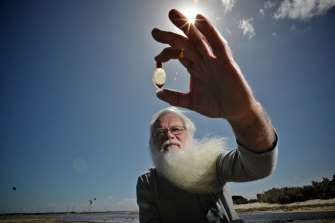
A significant part of the problem, she says, is precisely those little single-use plastic fish and food packets, and the death of the “refill system”: “When I was a child, I would go to a store and I would bring my bottle and [buy] maybe five or 10 [Philippine] pesos of [cooking] oil. That was the traditional way in most cultures in the region.
“That all changed when sachets and single-use plastic were introduced.”

A fish-shaped soy sauce container from Port Phillip Bay.Credit:Darren James
But that’s not even the worst of it.
A global system
The world produces around 1.8 billion tonnes of garbage every year. According to one report, if all this was put on dump trucks the line would circle the planet 24 times.
Approximately one-tenth of this refuse enters the global waste trade. This essentially translates to rich countries sending their waste to less economically advanced countries, like those in South-east Asia.
Around 12 per cent of municipal waste generated in the US is plastic, equating to 32.4 million tonnes in 2018. Countries such as the USA, Canada and South Korea are among the leaders in waste exporting. In 2018, the US transported an average of 429 large shipping containers of plastic waste alone every day.
Since China banned imports of waste from 2017, much of this garbage now ends up in Africa and Asia. Since these countries are often ill-equipped to deal with the influx - in South-east Asia, 75 per cent of it is not recycled - that means a lot of it ends up in waterways or oceans, either via direct dumping or simply being washed there by rains.
Loading
Greenpeace reported a 171 per cent increase to almost 2.25 million tonnes annually in plastic waste imported by South-east Asian countries between 2016-2018.
To this heaving swell of plastic waste, add a tsunami of plastic generated by COVID-19 measures around the world since early 2020. In the early stages of the outbreak, one NGO reported there were already 1.5 billion mainly plastic-based surgical masks in the world’s oceans. By 2021, an additional 140 million used test kits, 144,000 syringes and packaging from 8 billion vaccine doses were generated as governments sought to stem the virus.
Pandemic measures have also put many Asian waste businesses into lockdown, ensuring that even as the plastic continues flowing in, facilities are not operating and workers are stuck at home. Invariably the waste gets dumped, often illegally through murky waste trafficking channels.
A new deal?
At the entrance to the fifth session of the United Nations Environment Assembly in Nairobi, Kenya, in February, was an extraordinarily powerful sculpture by Canadian artist Benjamin von Wong: a tap, suspended in the sky, spews a stream of plastic trash onto the forecourt grass.

Artwork by Benjamin von Wong “Turn off the plastic tap” artwork outside the UN Environment Assembly in Nairobi.Credit:Stuff (NZ)
Maybe it had some effect, because the meeting rounded off with a major resolution to stop all plastic pollution by 2024.
Inger Andersen, executive director of the United Nations Environment Program (UNEP), said in a statement the agreement between 175 member nations is “the most important environmental deal since the Paris climate accord”.
Susan Gardner, director of UNEP’s ecosystems division, says: “Countries have said ‘We want to do something about plastics and this is urgent. We’re so serious about this we believe what’s needed is something legally binding.’”
Gardner referenced the Minamata Convention on mercury, which took some five years to launch in 2017. “In this case, member states are so determined ... that they want to do it in about half the time. That ambition, in terms of substance as well as the pace, is unprecedented.”
Big money lagging
But even a solid UN agreement may not be enough.
The Great Pacific Garbage Patch has been tracked since the 1980s and measures over 1.55 million square kilometres - more than twice the size of Texas. In 2016, it was predicted it would take until 2050 for plastic in the oceans to outweigh sea life. Now it seems we might get there this decade.
It’s possible to imagine that nations could adhere to their own measurements under a UN convention while shoving the plastic waste problem offshore and into the oceans.
With this in mind, Aguilar notes a regional process has been underway through the Association of South-East Asian Nations (ASEAN). This led to the Bangkok Declaration, issued in 2019.
But Aguilar says that agreement “is not looking at reduction, not looking at the source. So it was kind of problematic; more cure than prevention.”
That source has a name. Or more precisely, it has around a hundred names, those of the corporations largely responsible for manufacturing single-use plastic.
According to Australian NGO the Minderoo Foundation, around 60 per cent of the total investment in these companies comes from just 20 major banks, such as Barclays, HSBC and Bank of America.
The organisation reported in 2021 that “20 asset managers – led by US companies Vanguard Group, BlackRock and Capital Group – hold over $US300 billion worth of shares in the parent companies of single-use plastic polymer producers.
“Of this, $US10 billion is directly linked to single-use polymer production.”
As noted by Minderoo, Pennsylvania-based Vanguard Group is a significant investor in this sector. The asset manager invests in a number of the top 10 plastics manufacturers in the world.
In an email statement, a spokesperson for Vanguard said: “Regardless of industry, we expect companies to take into account government policies, commitments and regulation in their strategies and plans, particularly where the policy … results in a material exposure.”
A 2021 company report notes the investor met with 734 companies across 29 industries as part of its stewardship program. The categories of engagement are based on governance and material risk. There is no mention of plastic in the report even though four of the top 10 plastics producers (including both US-based companies in that group, ExxonMobil and Dow) were met.
Given most of these companies are transnational conglomerates, and given the asset manager’s listed categories of engagement, it seems unlikely that the issue of plastic pollution entered any of these formal meetings. On this evidence, as international and regional organisations seem to be getting more and more ambitious in curtailing plastic pollution in oceans and elsewhere, the corporate sector looks to be lagging.
UNEP’s Gardner notes that on current trends, we will be doubling our already gigantic plastic footprint “in the next decade or so”: “It is very much the way we use plastics which has created this problem.”
She adds the solution “does require systemic change across the entire value chain”. That is almost certain to mean increasing pressure on plastics manufacturers in the coming years.
J.J. Rose is an Australian-based author and keen bodysurfer.









 Add Category
Add Category